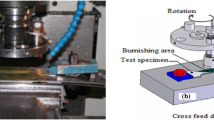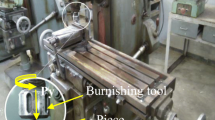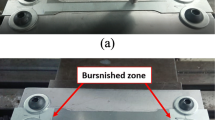Abstract
Ball burnishing is a superfinishing operation performed to improve surface and subsurface integrity. In the present study, a model was developed to confirm that the ball burnishing of AISI 8620 steel affects its microstructures, roughness, and residual stress. As a part of the process, the influence of different parameters on the residual stress surface in the axial direction was investigated. Samples were prepared by heat treatment and turning. The ball-burnishing process was performed, and the improvements on the surface and subsurface integrity were found to be significant. Residual stress after ball burnishing was found to be affected by pressure and feed rate to a statistically significant extent. Stress was found to be in the form of compression. The steel displayed significant improvements in surface roughness and residual stress following burnishing. The linear regression models derived from the data for the relationship between burnishing factors and residual stress offer R2 values of 80.88%. Results suggest that the ball-burnishing process enhanced the properties of AISI 8620 steel.












Similar content being viewed by others
References
Loh NH, Tam SC (1988) Effects of ball burnishing parameters on surface finish—a literature survey and discussion. Precis Eng 10:215–220. https://doi.org/10.1016/0141-6359(88)90056-6
Grzesik W, Krzysztof Z (2012) Modification of surface finish produced by hard turning using superfinishing and burnishing operations. J Mater Process Technol 212:315–322. https://doi.org/10.1016/j.jmatprotec.2011.09.017
Davim JP (ed) (2008) Machining of hard materials. Springer, London, pp v–vi. https://doi.org/10.1007/978-1-84800-213-5
Grzesik W (2017) Advanced machining processes of metallic materials, 2nd edn. Elsevier, Amsterdam, pp 285–397. https://doi.org/10.1016/b978-0-444-63711-6.00015-6
Revankar GD, Shetty R, Rao SS, Gaitonde VN (2014) Analysis of surface roughness and hardness in ball burnishing of titanium alloy. Measurement 58:256–268. https://doi.org/10.1016/j.measurement.2014.08.043
Okada M, Shinya M, Matsubara H, Kozuka H, Tachiya H, Asakawa N, Otsu M (2017) Development and characterization of diamond tip burnishing with a rotary tool. J Mater Process Technol 244:106–115. https://doi.org/10.1016/j.jmatprotec.2017.01.020
Hassan AM (1997) The effects of ball- and roller-burnishing on the surface roughness and hardness of some non-ferrous metals. J Mater Process Technol 72:385–391. https://doi.org/10.1016/S0924-0136(97)00199-4
Hassan AM, Al-Jalilb HF, Ebieda AA (1998) Burnishing force and number of ball passes for the optimum surface finish of brass components. J Mater Process Technol 83:176–179. https://doi.org/10.1016/S0924-0136(98)00058-2
Konefal K, Korzynski M, Byczkowska Z, Korzynska K (2013) Improved corrosion resistance of stainless steel X6CrNiMoTi17-12-2 by slide diamond burnishing. J Mater Process Technol 213:1997–2004. https://doi.org/10.1016/j.jmatprotec.2013.05.021
El-Axir MH, Ibrahim AA (2005) Some surface characteristics due to center rest ball burnishing. J Mater Process Technol 167:47–53. https://doi.org/10.1016/j.jmatprotec.2004.09.078
Jawahir IS, Brinksmeier E, M’Saoubi R, Aspinwall DK, Outeiro JC, Meyer D (2011) Surface integrity in material removal processes: recent advances. CIRP Ann Manuf Technol 60:603–626. https://doi.org/10.1016/j.cirp.2011.05.002
Korzynski M, Lubas J, Swirad S, Dudek K (2011) Surface layer characteristics due to slide diamond burnishing with a cylindrical-ended tool. J Mater Process Technol 211:84–94. https://doi.org/10.1016/j.jmatprotec.2010.08.029
Korzynski M, Pacana A (2010) Centreless burnishing and influence of its parameters on machining effects. J Mater Process Technol 210:1217–1223. https://doi.org/10.1016/j.jmatprotec.2010.03.008
Valiorgue F, Zmelty V, Dumas M, Chomienne V, Verdu C, Lefebvre F, Rech J (2018) Influence of residual stress profile and surface microstructure on fatigue life of a 15-5PH. Procedia Eng 213:623–629. https://doi.org/10.1016/j.proeng.2018.02.058
Zhang T, Bugtai N, Marinescu ID (2015) Burnishing of aerospace alloy: a theoretical–experimental approach. J Manuf Syst 37:472–478. https://doi.org/10.1016/j.jmsy.2014.11.004
De Lacalle LN, Lamikiz A, Muñoa J, Sánchez JA (2005) Quality improvement of ball-end milled sculptured surfaces by ball burnishing. Int J Mach Tool Manu 15:1659–1668. https://doi.org/10.1016/j.ijmachtools.2005.03.007
Mhaede M (2012) Influence of surface treatments on surface layer properties: fatigue and corrosion fatigue performance of AA7075 T73. MATER DESIGN 41:61–66. https://doi.org/10.1016/j.matdes.2012.04.056
Pu Z, Song GL, Yang S, Outeiro JC, Dillon OW, Puleo DA, Jawahir IS (2012) Grain refined and basal textured surface produced by burnishing for improved corrosion performance of AZ31B Mg alloy. Corros Sci 57:192–201. https://doi.org/10.1016/j.corsci.2011.12.018
Abrão AM, Denkena B, Köhler J, Breidenstein B, Mörke T (2014) The influence of deep rolling on the surface integrity of AISI 1060 high carbon steel. Procedia CIRP 13:31–36. https://doi.org/10.1016/j.procir.2014.04.006
Kermouche G, Rech J, Hamdi H, Bergheau JM (2010) On the residual stress field induced by a scratching round abrasive grain. Wear 269:86–92. https://doi.org/10.1016/j.wear.2010.03.012
Daniel C, Wood FS, Lucas JM (1981) Fitting equations to data: computer analysis of multifactor data. Technometrics 23:203–204. https://doi.org/10.2307/1268046
Sagbas A (2011) Analysis and optimization of surface roughness in the ball burnishing process using response surface methodology and desirability function. Adv Eng Softw 42:992–998. https://doi.org/10.1016/j.advengsoft.2011.05.021
Rodríguez A, López de Lacalle LN, Celaya A, Lamikiz A, Albizuri J (2011) Surface improvement of shafts by the deep ball-burnishing technique. Surf Coat Technol 206:2817–2824. https://doi.org/10.1016/j.surfcoat.2011.11.045
Yen YC, Sartkulvanich P, Altan T (2005) Finite element modeling of roller burnishing process. CIRP Ann 54:237–240. https://doi.org/10.1016/S0007-8506(07)60092-4
Alberto S (2016) Ball-burnishing process: state of the art of a technology in development. Universidad de Guanajuato, Dissertation
Taha NK, Youssef HA, Bayoumi AE, Y, Mashal A-H (1994) The effect of cutting parameters on residual stress and average flank pressure on 11L17 steel and 2024 aluminum alloy during milling operation. MEATIP1, Assiut University, Asyut
Mahajan D, Tajane R (2013) A review on ball burnishing process. Int J Sci Res Publ 3:2250–3153
Travieso-Rodríguez JA, Gómez-Gras G, Dessein G, et-al. (2015) Effects of a ball-burnishing process assisted by vibrations in G10380 steel specimens. Int J Adv Manuf Technol 81:1757–1765. https://doi.org/10.1007/s00170-015-7255-3
Liu Y, Wang L, Wang D (2011) Finite element modeling of ultrasonic surface rolling process. J. Mater Process Technol 211:2106–2113
Le Roux S, Cutard T, Lours P (2015) Quantitative assessment of the interfacial roughness in multi-layered materials using image analysis: application to oxidation in ceramic-based materials. J Eur Ceram Soc 35:1063–1079. https://doi.org/10.1016/j.jeurceramsoc.2014.09.027
Lawrence J, Waugh D (2015) Laser surface engineering: processes and applications. Woodhead, Glossop
Klocke F, Liermann J (1998) Roller burnishing of hard turned surfaces. Int J Mach Tool Manu 38:419–423. https://doi.org/10.1016/S0890-6955(97)00085-0
Mezlini S, Mzal S, Sghaier S, Braham C, Kapsa PH (2013) Effect of a combined machining/burnishing tool on the roughness and mechanical properties. Lubr Sci 26:175–187. https://doi.org/10.1002/ls.1239
Author information
Authors and Affiliations
Corresponding author
Ethics declarations
Conflict of interest
The authors declare that they have no conflicts of interest.
Additional information
Publisher’s note
Springer Nature remains neutral with regard to jurisdictional claims in published maps and institutional affiliations.
Rights and permissions
About this article
Cite this article
Alshareef, A.J., Marinescu, I.D., Basudan, I.M. et al. Ball-burnishing factors affecting residual stress of AISI 8620 steel. Int J Adv Manuf Technol 107, 1387–1397 (2020). https://doi.org/10.1007/s00170-020-05119-x
Received:
Accepted:
Published:
Issue Date:
DOI: https://doi.org/10.1007/s00170-020-05119-x




